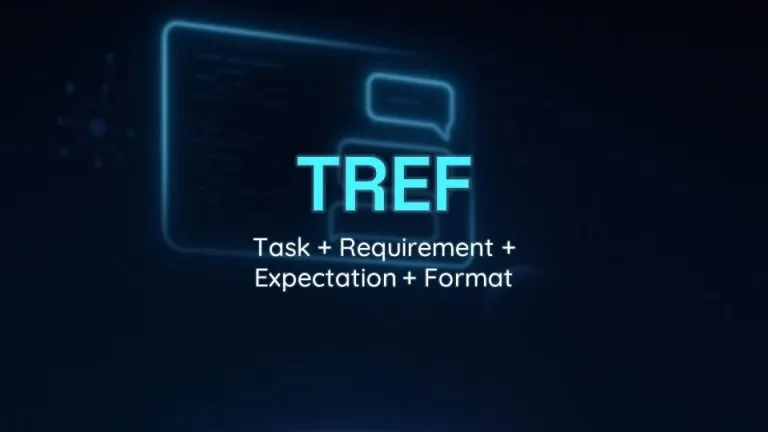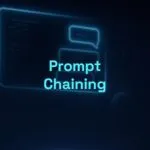TREF Framework: Task, Requirement, Expectation, Format

When creating prompts for AI, what’s often missing is a good balance of clarity, direction, and a clearly expected outcome. That’s exactly what the TREF framework delivers — a concise and practical structure to guide AI with precision, even for simple or one-off tasks.
TREF is ideal when you know what you want but need to ensure the AI understands the essential criteria of your request — what needs to be done, which conditions to respect, what level of quality is expected, and how the content should be delivered.
What Is the TREF Framework?
The TREF framework is a simple and direct structure that guides the AI to perform a specific task according to your needs. Its four elements create focused, easy-to-follow prompts that deliver results you can use right away. Here’s how each part works:
Framework Components
- Task: Defines what you want the AI to do, like “create a plan” or “explain a concept.”
- Requirement: Specifies key conditions or necessary details, such as “based on X” or “using simple examples.”
- Expectation: Describes what kind of result you want, such as “a practical solution” or “a clear explanation.”
- Format: Tells how the response should be presented — a “numbered list,” “table,” or “short paragraph.”
Together, these components form a direct prompt that minimizes ambiguity and emphasizes what matters.
When to Use It?
TREF is perfect when you need something quick, practical, and well-organized. Use it if:
- You want a task completed with specific conditions.
- You need results aligned with a clear objective.
- You’re looking for structured output to apply or share.
- You want a fast but well-targeted response.
💡 Use TREF when you want a ready-to-use, no-frills answer.
Typical example: “Do [Task], following [Requirement], to ensure [Expectation], in [Format].”
Practical Examples of TREF in Action
To show how TREF works, here are three real-world applications. See how it organizes requests clearly and effectively.
Example 1: Social Media Content Plan
Context: You’re a freelancer creating posts for a fitness client.
Create a social media content plan (Task), based on at-home workout tips (Requirement), to make it simple and motivational (Expectation), in a 5-day table including date and description (Format).Why it works: The Task sets the goal, the Requirement defines the theme, the Expectation sets the tone, and the Format organizes the delivery.
Example 2: Explaining Blockchain
Context: You need to understand blockchain for a meeting, with no technical background.
Explain what blockchain is (Task), using simple language and a real-life example (Requirement), so it’s easy to understand (Expectation), in a short paragraph (Format).Why it works: The Task is clear, the Requirement simplifies the concept, the Expectation sets the clarity level, and the Format keeps it brief.
Example 3: Project Task List
Context: You’re starting a design project and need to organize your work.
Create a task list for starting a design project (Task), considering a one-week timeline (Requirement), to make it practical and realistic (Expectation), in a numbered list with 4 items (Format).Why it works: The Task states the need, the Requirement adds the timeframe, the Expectation ensures feasibility, and the Format organizes the output.
Tips to Get the Most Out of TREF
TREF is practical and straightforward, but fine-tuning each part can make it even more effective. Here’s how to adapt it to your specific goals.
Customize for Your Objective
Adjust the TREF components to reflect exactly what you need:
- Task: Be precise. “Write something” is vague; “Generate 3 title ideas” is clear.
- Requirement: Include what matters. “About marketing” is broad; “based on social media trends” is focused.
- Expectation: Set tone or complexity. “Useful” is vague; “practical for beginners” is specific.
- Format: Be intentional. Lists are fast, tables compare, paragraphs explain — think about your final use.
Quick Example:
“Suggest workshop themes (Task), using 2025 tech trends (Requirement), to make it innovative and relevant (Expectation), in a list of 3 short items (Format).”
These adjustments make TREF flexible and perfect for any situation — from the simplest to the most specific.
Start Using TREF Today
With the TREF – Task, Requirement, Expectation, Format framework, you have a practical structure for creating objective, well-organized prompts. Whether planning, explaining, or brainstorming, it helps the AI deliver clear, usable results — saving you time and effort.
🎯 Quick Summary:
TREF tells the AI what to do (Task), under which conditions (Requirement), what the output should be like (Expectation), and in what form (Format).
🔗 Want to explore more frameworks like this?
Check out the Practical Guide to Prompt Techniques, Frameworks, and Formulas for LLMs, with dozens of detailed and applicable structures for different contexts and goals, plus techniques and prompt engineering tips.
📘 Bonus tip:
Download the free eBook “Prompt Engineering Unveiled”, featuring easy explanations, practical examples, and strategies ranging from basic to advanced to master communication with AI.



